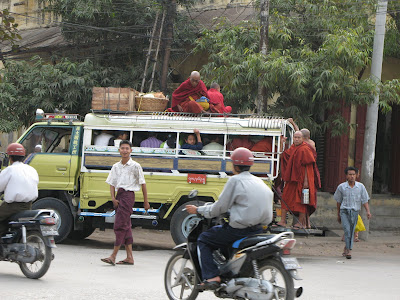
Mandalay was founded in 1857 and is the second largest city in Burma. Forty percent of the monks in Burma reside in and around Mandalay. They are seen everywhere around the city from dawn until dusk.








The city of is named after Mandalay Hill which sit in the north eastern part of the city.
Mandalay most likely evolved from the words Mandala (circular plains), Mandare (auspicious land), or Mandara (from Hindu mythology meaning hill).
No visit is complete without a visit to the temple on top of Mandalay Hill.
Be warned that no footwear is permitted on temple grounds. If you approach the temple from the city base, or the main portal to the temple, it will involved a long climb, barefooted, to the temple above.
You can, however, take a shuttle truck up to the temple and walk down from there.
The one sight not to be missed in all of Mandalay is the Mah Muni Buddha.
It is believed that the Image is one of only five cast during the life of the Gautama Buddha and that the Buddha embraced it 7 times thereby bringing it to life. Devout Buddhists hold it to be alive and refer to it as the Maha Muni Sacred Living Image. The Buddha was originally brought from Rakhine State and is also referred to as the Great Rakhine Buddha.Revered as the holiest pagoda in Mandalay. The image in a sitting posture is 12 feet and 7 inches high. The early morning ritual of washing the Face of Buddha Image draws a large crowd of devotees everyday. It is considered to be the second most sacred Image, after the Shwedagon Pagoda, in all of Burma.
Tourists are encouraged by resident monks to pay tribute to the Buddha by applying gold leaf to the body of the Image. If you're not asked to make a small donation, please offer one.
The Buddha Image has taken on an irregular outline with about two inches of gold leaf applied to it over the years.


In a courtyard of the Maha Muni temple, are six Khmer bronze statues (three lions, a three-headed elephant and two warriors) that originally stood as guardians of Cambodia's Angkor Wat temple. The statues of the warriors are reputed to have miraculous healing qualities. Legends tell that rubbing a body part of either of the statues will cure an affliction in the corresponding part of your own body.

The Great Gong on the grounds of the Maha Muni temple.
In the center of the city is the Mandalay Palace, originnally built for and occupied by the Burmese Royal Family until the British took over the country in 1885. Some taxi drivers will refuse to take you there saying that you should stay away because it was rebuilt with forced labour. We chose not to visit.
A moat circles the entire one square kilometer grounds. Tourists enter through the West Gate.
When You Go:
* Before traveling to Burma, contact a travel agent who can arrange a transit letter for you. You will need this when applying for an entry visa into Myanmar. We used Myanmar Tourex. They can make hotel and internal air reservations for your trip, arrange airport transfers, as well as private tours. A paypal deposit is required after setting-up the trip and the balance is paid on arrival (USD cash).
* Stay away from government run hotels, travel agencies, and airlines. Support the local independent merchants. When shopping in the large tourist marketplaces, the government run merchants are clearly labeled as such.
* Don't miss the Maha Muni Buddha Image, Mandalay Hill, and the local markets in the Chinatown area.
Mandalay time:
 Mandalay was founded in 1857 and is the second largest city in Burma. Forty percent of the monks in Burma reside in and around Mandalay. They are seen everywhere around the city from dawn until dusk.
Mandalay was founded in 1857 and is the second largest city in Burma. Forty percent of the monks in Burma reside in and around Mandalay. They are seen everywhere around the city from dawn until dusk.








.jpg)





No comments:
Post a Comment